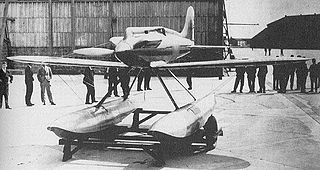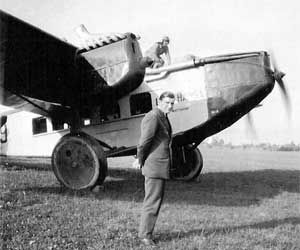
The Junkers F 13 is the world's first all-metal transport aircraft, designed and produced by the German aircraft manufacturer Junkers.

The Junkers A50 Junior is an all-metal sports plane designed and produced by the German aircraft manufacturer Junkers.

The Supermarine S.6B is a British racing seaplane developed by R.J. Mitchell for the Supermarine company to take part in the Schneider Trophy competition of 1931. The S.6B marked the culmination of Mitchell's quest to "perfect the design of the racing seaplane" and represented the cutting edge of aerodynamic technology for the era.

The Supermarine Southampton was a flying boat of the interwar period designed and produced by the British aircraft manufacturer Supermarine. It was one of the most successful flying boats of the era.

The Supermarine S.6 is a 1920s British single-engined single-seat racing seaplane built by Supermarine and designed by its chief designer, R.J. Mitchell, who refined the earlier Supermarine S.5 to produce a larger, more powerful aircraft. Two aircraft, N247 and N248, were built to participate in the 1929 Schneider Trophy contest. Rolls-Royce produced the R engine for the new all-metal aircraft. The engine's initial issues—such as the short time between overhauls and the heat generated when the engine power was increased to 1,900 hp (1,400 kW)—were resolved within a few months before the aircraft were completed at Supermarine’s works at Woolston, Southampton.

The Macchi M.39 was a racing seaplane designed and built by the Italian aircraft manufacturer Aeronautica Macchi. The type is most remembered for its settings of multiple world speed records during the mid 1920s, as well as for winning the Schneider Trophy, for which the M.39 had been specifically developed.

The Supermarine S.4 was a 1920s British single-engined monoplane built by the company Supermarine. Designed by a team led by the company's chief designer, R. J. Mitchell, it was designed to compete in the 1925 Schneider Trophy contest.

The Fiat CR.20 was a biplane fighter designed and produced by the Italian aircraft manufacturer Fiat. It represented an intermediate step from the early biplane CR.1 and the later, successful series CR.30, CR.32 and CR.42.
The Caproni Ca.97 was a utility monoplane aircraft designed and produced by the Italian aircraft manufacturer Caproni. It had a range of powerplant arrangements, the aircraft could be flown with many as three radial engines, however, many were build with only the nose engine present or with only the two nacelle-mounted engines.

The Dornier Komet (Comet), Merkur (Mercury), Do C, Do D, and Do T were a family of aircraft designed and manufactured by the German aircraft manufacturer Dornier Flugzeugwerke.

The Hanriot H.43 was a military utility biplane designed and produced by the French aircraft manufacturer Hanriot. It was primarily used by the Aéronautique Militaire as a trainer aircraft during the interwar period.

The Short Crusader also called the Short-Bristow Crusader and Short-Bristol Crusader was a British racing seaplane of the 1920s, built by Short Brothers to compete in the 1927 Schneider Trophy race.

The RAF High Speed Flight, sometimes known as 'The Flight' , was a small flight of the Royal Air Force (RAF) formed for the purpose of competing in the Schneider Trophy contest for racing seaplanes during the 1920s. The flight was together only until the trophy was won outright, after which it was disbanded.

The Gloster III was a British racing floatplane of the 1920s intended to compete for the Schneider Trophy air race. A single-engined, single-seat biplane, two were built, with one finishing second in the 1925 race.

The Gloster IV was a British racing floatplane of the 1920s. A single-engined biplane, the Gloster IV was a development of the earlier Gloster III intended to compete in the 1927 Schneider Trophy race. One aircraft competed in the race, but retired part way through. The three aircraft built continued to be used as trainers by the High Speed Flight for several years.

The Rohrbach Ro VIII Roland was an semi-cantilever monoplane trimotor airliner designed and produced by the German aircraft manufacturer Rohrbach. It was capable of unrivalled performance in some categories; during its early years, the type held no less than 22 world records.

The Short S.7 Mussel was a single-engined two-seat monoplane built by Short Brothers to test the performance of their duralumin monocoque floats. Two were built.

The Bernard H.V.120 was a racing seaplane designed and built by the French aircraft manufacturer Bernard. It was developed specifically to compete in the Schneider Trophy race.

The Les Mureaux 3 C.2 and Les Mureaux 4 C.2 were French two seat, parasol winged fighters, flown in 1927-8, which differed only in their engines. They were developed into near identical army co-operation types, the ANF Les Mureaux 130 A.2 and ANF Les Mureaux 131 A.2, in 1929–31.
The Nieuport-Delage NiD 450 was a French racing floatplane, originally intended to compete for the 1929 Schneider Trophy. After the French decided not to participate that year, the type was used as the NiD 650 to speed the development of the proposed entrants to the 1931 event, the NiD 651 and NiD 652. Delays in producing the latters' engines left these unflown.


















